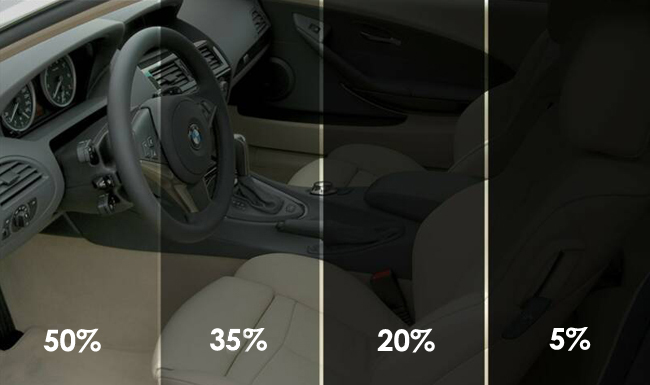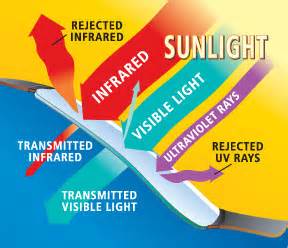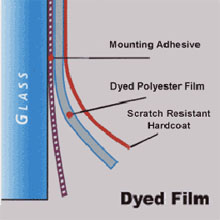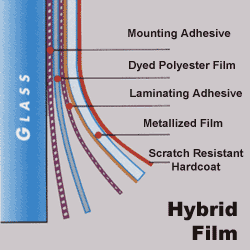A Razor’s Edge believes in educating the customer in order to help facilitate an informed purchase commensurate with everyone’s specific needs. In this regard, the following are a few terms you can familiarize yourself with when considering what tint is right for your vehicle:
Tint Levels—This is how dark or light the tint film itself is, and is measured in percentage form. The lower the percentage number, the darker the tint. For example, 35% tint level (which is the legal limit for front door windows in Arizona) is lighter than 5% tint level (commonly referred to as Limo Tint). Many customers choose to combine tint levels, like putting 35% on the front doors, and 5% on the rear of the vehicle in order to stay legally compliant but also maximize solar protection. The film A Razor’s Edge carries comes in a wide variety of levels depending on your tinting wants and needs.
Many customers choose to combine tint levels, like putting 35% on the front doors, and 5% on the rear of the vehicle in order to stay legally compliant but also maximize solar protection. The film A Razor’s Edge carries comes in a wide variety of levels depending on your tinting wants and needs.
Total Solar Energy Rejection (TSER)—This is how much heat the film will prohibit from entering the vehicle through the windows. This is also measured in percentage form. For example, 56% TSER is better than 43% TSER when it comes to heat rejection.
Infrared (IR) and Ultraviolet (UV) Rejection—This refers to how much of the Sun’s harmful rays are blocked by window film. IR/UV rejection is not the same as heat rejection, but they are similar. Many higher line tints have a higher IR/UV rejection, which helps preserve the vehicle’s interior, as well as its occupants, better than film with a lower IR/UV rejection percentage.
Dyed Construction Film—Dyed tint film has long been considered the industry standard for automotive tinting. This film is usually between 2 and 4-ply, with dye injected in between each layer. Dyed construction film is usually the entry level, less-expensive option when presented with multiple choices. It has lower TSER and IR/UV rejection than more advanced lines of film.  It is also the film notorious for changing colors after years of solar exposure. Although dyed film technology has advanced since its inception, it rarely if ever comes with a no-fade guarantee, and users can expect to get between 3-5 years optimal usage from this film before it begins to change colors and weaken.
It is also the film notorious for changing colors after years of solar exposure. Although dyed film technology has advanced since its inception, it rarely if ever comes with a no-fade guarantee, and users can expect to get between 3-5 years optimal usage from this film before it begins to change colors and weaken.
High Performance Film—High Performance film is usually a hybrid of dyed construction and metal flake technology. For many years, metallic film was considered a step up from the standard, in both performance and price. The metal flake construction usually has a higher TSER and IR/UV rejection percentage than dyed construction film, and also has a shinier, more metallic appearance than standard dyed construction film. This film can be tricky to use on some newer vehicles because sometimes the metal construction interfere with on-board computer/navigation systems, and other electronic devices. This is a film that sometime comes with a limited lifetime no fade guarantee and is generally considered more fade resistant than standard dyed construction film. Users can usually expect between 5-7 years optimal usage from this film before it might begin to fade.
This film can be tricky to use on some newer vehicles because sometimes the metal construction interfere with on-board computer/navigation systems, and other electronic devices. This is a film that sometime comes with a limited lifetime no fade guarantee and is generally considered more fade resistant than standard dyed construction film. Users can usually expect between 5-7 years optimal usage from this film before it might begin to fade.
Carbon Film—Carbon film is new and advanced technology that is revolutionizing the window film world. Unlike dyed films, carbon film does not use any dyes, and instead uses a carbon filament technology where carbon is actually infused in the layer of film. This results in a very high TSER and IR/UV rejection percentage versus dyed construction films, and a usually darker color versus metallic films. Because this film is dye free, it comes with a lifetime no fade guarantee. It also will not interfere with electrical navigation and on-board computer systems like metal film will. Some companies including SunTek have several lines of Carbon style films, in which TSER and IR/UV rejection percentages vary depending on the model of film. This film is usually a bit more expensive than standard films, but also has upwards of 33% more rejection properties than standard films, including enhanced IR/UV protection, making the extra money spent is well worth it.
Ceramic Film—Ceramic film is usually considered the standard on high-end vehicles including Mercedes Benz and Ferrari but can be put on any vehicle just the same. This film uses a ceramic coating to produce a very effective protection barrier from TSER and IR/UV rays. This is extremely efficient window film for sure. Ceramic films as a whole have less reflection than glass, and has more of a flat look than black or carbon films, and usually comes with a lifetime no fade guarantee like the Carbon films do. It is also the most expensive of all tint films.
This is extremely efficient window film for sure. Ceramic films as a whole have less reflection than glass, and has more of a flat look than black or carbon films, and usually comes with a lifetime no fade guarantee like the Carbon films do. It is also the most expensive of all tint films.
